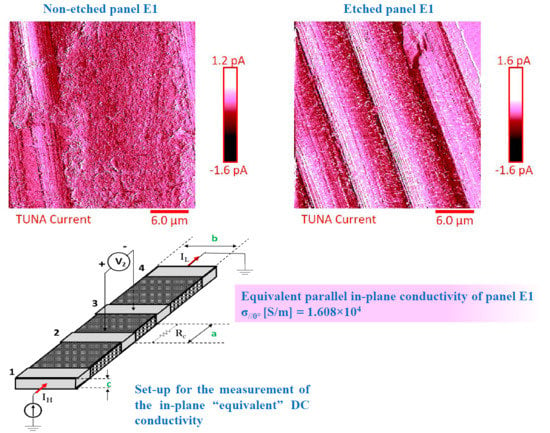Electrical Current Map and Bulk Conductivity of Carbon Fiber-Reinforced Nanocomposites
Abstract
1. Introduction
2. Experimental
2.1. Materials
Epoxy Formulations D and E (Without CFs)
2.2. Carbon Fiber-Reinforced Composites (CFRCs)
CFRCs—Manufacturing Process (Panels D, E1, E2 and E3)
2.3. Methods
2.3.1. Differential Scanning Calorimetry (DSC) Thermal Analysis
2.3.2. Rheological Measurements
2.3.3. Morphological Analysis: Field Emission Scanning Electron Microscopy (FESEM) and High-Resolution Transmission Electron Microscopy (HRTEM)
2.3.4. Energy Dispersive X-ray (EDX) Analysis
2.3.5. Tunneling Atomic Force Microscopy (TUNA) Measurements
2.3.6. Electrical Measurements
3. Results and Discussion
3.1. Curing Cycle and Cure Degree of the Resin Impregnating the Panels
3.2. Rheological Measurements of Sample E
3.3. FESEM and HRTEM Morphological Analysis of the Carbon Nanotubes (MWCNTs)
3.4. FESEM and TUNA Morphological Analysis of the Nanocomposite TBD + 5% GPOSS + 0.5% MWCNT (Formulation E)
3.5. FESEM and TUNA Morphological Analysis of CFRCs (Panels E1, E2 and E3)
3.6. Electrical Properties
Effect of the Plies Number on the Electrical Properties
3.7. Effect of GPOSS on the Electrical Properties
4. Conclusions
Supplementary Materials
Author Contributions
Funding
Conflicts of Interest
References
- Raimondo, M.; Russo, S.; Guadagno, L.; Longo, P.; Chirico, S.; Mariconda, A.; Bonnaud, L.; Murariu, O.; Dubois, P. Effect of incorporation of POSS compounds and phosphorous hardeners on thermal and fire resistance of nanofilled aeronautic resins. RSC Adv. 2015, 5, 10974–10986. [Google Scholar] [CrossRef]
- Raimondo, M.; Guadagno, L.; Speranza, V.; Bonnaud, L.; Dubois, P.; Lafdi, K. Multifunctional graphene/POSS epoxy resin tailored for aircraft lightning strike protection. Compos. Part B Eng. 2018, 140, 44–56. [Google Scholar] [CrossRef]
- Toldy, A.; Szolnoki, B.; Marosi, G. Flame retardancy of fibre-reinforced epoxy resin composites for aerospace applications. Polym. Degrad. Stab. 2011, 96, 371–376. [Google Scholar] [CrossRef]
- Guo, W.; Yu, B.; Yuan, Y.; Song, L.; Hu, Y. In situ preparation of reduced graphene oxide/DOPO-based phosphonamidate hybrids towards high-performance epoxy nanocomposites. Compos. Part B Eng. 2017, 123, 154–164. [Google Scholar] [CrossRef]
- Frigione, M.; Maffezzoli, A.; Finocchiaro, P.; Failla, S. Cure kinetics and properties of epoxy resins containing a phosphorous-based flame retardant. Adv. Polym. Technol. J. Polym. Process. Inst. 2003, 22, 329–342. [Google Scholar] [CrossRef]
- Oliwa, R.; Heneczkowski, M.; Oleksy, M.; Galina, H. Epoxy composites of reduced flammability. Compos. Part B Eng. 2016, 95, 1–8. [Google Scholar] [CrossRef]
- Sun, F.; Yu, T.; Hu, C.; Li, Y. Influence of functionalized graphene by grafted phosphorus containing flame retardant on the flammability of carbon fiber/epoxy resin (CF/ER) composite. Compos. Sci. Technol. 2016, 136, 76–84. [Google Scholar] [CrossRef]
- Zhao, Q.; Zhang, K.; Zhu, S.; Xu, H.; Cao, D.; Zhao, L.; Zhang, R.; Yin, W. Review on the Electrical Resistance/Conductivity of Carbon Fiber Reinforced Polymer. Appl. Sci. 2019, 9, 2390. [Google Scholar] [CrossRef]
- Alemour, B.; Bradan, O.; Hassan, M.R. A Review of Using Conductive Composite Materials in Solving Lightening Strike and Ice Accumulation Problems in Aviation. J. Aerosp. Technol. Manag. 2019, 11, e1919. [Google Scholar] [CrossRef]
- Li, J.; Zhu, C.; Zhao, Z.; Khalili, P.; Clement, M.; Tong, J.; Liu, X.; Yi, X. Fire properties of carbon fiber reinforced polymer improved by coating nonwoven flame retardant mat for aerospace application. J. Appl. Polym. Sci. 2019, 136, 47801. [Google Scholar] [CrossRef]
- Polydoropoulou, P.; Katsiropoulos, C.V.; Pantelakis, S.G.; Raimondo, M.; Guadagno, L. A critical assessment of multifunctional polymers with regard to their potential use in structural applications. Compos. Part B Eng. 2019, 157, 150–162. [Google Scholar] [CrossRef]
- Kausar, A.; Rafique, I.; Muhammad, B. Significance of Carbon Nanotube in Flame-Retardant Polymer/CNT Composite: A Review. Polym. Plast. Technol. Eng. 2017, 56, 470–487. [Google Scholar] [CrossRef]
- Kobzeva, V.A.; Chechenina, N.G.; Bukunova, K.A.; Vorobyevaa, E.A.; Makunina, A.V. Structural and functional properties of composites with carbon nanotubes for space applications. Mater. Today Proc. 2018, 5, 26096–26103. [Google Scholar] [CrossRef]
- Kinloch, I.A.; Suhr, J.; Lou, J.; Young, R.J.; Ajayan, P.M. Composites with carbon nanotubes and graphene: An outlook. Science 2018, 362, 547–553. [Google Scholar] [CrossRef] [PubMed]
- Randjbaran, E.; Zahari, R.; Majid, D.L.; Sultan, M.T.H.; Mazlan, N. Reasons of adding carbon nanotubes into composite systems - review paper. Mech. Mech. Eng. 2017, 21, 549–568. [Google Scholar]
- Toldy, A.; Szebényi, G.; Molnár, K.; Tóth, L.F.; Magyar, B.; Hliva, V.; Czigány, T.; Szolnoki, B. The Effect of Multilevel Carbon Reinforcements on the Fire Performance, Conductivity, and Mechanical Properties of Epoxy Composites. Polymers 2019, 11, 303. [Google Scholar] [CrossRef] [PubMed]
- Zhou, H.W.; Mishnaevsky, L.; Yi, H.Y.; Liu, Y.Q.; Hu, X.; Warrier, A.; Dai, G.M. Carbon fiber/carbon nanotube reinforced hierarchical composites: Effect of CNT distribution on shearing strength. Compos. Part B Eng. 2016, 88, 201–211. [Google Scholar] [CrossRef]
- Raimondo, M.; De Nicola, F.; Volponi, R.; Binder, W.; Michael, P.; Russo, S.; Guadagno, L. Self-repairing CFRPs targeted towards structural aerospace applications. Int. J. Struct. Integr. 2016, 7, 656–670. [Google Scholar] [CrossRef]
- Guadagno, L.; Vietri, U.; Raimondo, M.; Vertuccio, L.; Barra, G.; De Vivo, B.; Lamberti, P.; Spinelli, G.; Tucci, V.; De Nicola, F. Correlation between electrical conductivity and manufacturing processes of nanofilled carbon fiber reinforced composites. Compos. Part B Eng. 2015, 80, 7–14. [Google Scholar] [CrossRef]
- Guadagno, L.; Raimondo, M.; Vietri, U.; Vertuccio, L.; Barra, G.; De Vivo, B.; Lamberti, P.; Spinelli, G.; Tucci, V.; Volponi, R. Effective formulation and processing of nanofilled carbon fiber reinforced composites. RSC Adv. 2015, 5, 6033–6042. [Google Scholar] [CrossRef]
- Carolan, D.; Ivankovic, A.; Kinloch, A.; Sprenger, S.; Taylor, A. Toughened carbon fibre-reinforced polymer composites with nanoparticle-modified epoxy matrices. J. Mater. Sci. 2017, 52, 1767–1788. [Google Scholar] [CrossRef]
- Jin, F.-L.; Park, S.-J. Preparation and characterization of carbon fiber-reinforced thermosetting composites: A review. Carbon Lett. 2015, 16, 67–77. [Google Scholar] [CrossRef]
- Barra, G.; De Nicola, F.; De Vivo, B.; Egiziano, L.; Guadagno, L.; Lamberti, P.; Raimondo, M.; Spinelli, G.; Tucci, V.; Vertuccio, L.; et al. Enhanced electrical properties of carbon fiber reinforced composites obtained by an effective infusion process. In Proceedings of the 2014 IEEE 9th Nanotechnology Materials and Devices Conference (NMDC), Aci Castello, Italy, 12–15 October 2014; pp. 88–91. [Google Scholar]
- Raimondo, M.; Guadagno, L.; Vertuccio, L.; Naddeo, C.; Barra, G.; Spinelli, G.; Lamberti, P.; Tucci, V.; Lafdi, K. Electrical conductivity of carbon nanofiber reinforced resins: Potentiality of Tunneling Atomic Force Microscopy (TUNA) technique. Compos. Part B Eng. 2018, 143, 148–160. [Google Scholar] [CrossRef]
- Guadagno, L.; Raimondo, M.; Vertuccio, L.; Naddeo, C.; Barra, G.; Longo, P.; Lamberti, P.; Spinelli, G.; Nobile, M. Morphological, rheological and electrical properties of composites filled with carbon nanotubes functionalized with 1-pyrenebutyric acid. Compos. Part B Eng. 2018, 147, 12–21. [Google Scholar] [CrossRef]
- De Vivo, B.; Guadagno, L.; Lamberti, P.; Raimondo, M.; Spinelli, G.; Tucci, V.; Vertuccio, L.; Vittoria, V. Electrical properties of multi-walled carbon nanotube/tetrafunctional epoxy-amine composites. AIP Conf. Proc. 2012, 1459, 199–201. [Google Scholar] [CrossRef]
- Naddeo, C.; Vertuccio, L.; Barra, G.; Guadagno, L. Nano-charged polypropylene application: Realistic perspectives for enhancing durability. Materials 2017, 10, 943. [Google Scholar] [CrossRef] [PubMed]
- Bellucci, S.; Coderoni, L.; Micciulla, F.; Rinaldi, G.; Sacco, I. The electrical properties of epoxy resin composites filled with CNTs and carbon black. J. Nanosci. Nanotechnol. 2011, 11, 9110–9117. [Google Scholar] [CrossRef] [PubMed]
- Guadagno, L.; Raimondo, M.; Vittoria, V.; Vertuccio, L.; Naddeo, C.; Russo, S.; De Vivo, B.; Lamberti, P.; Spinelli, G.; Tucci, V. Development of epoxy mixtures for application in aeronautics and aerospace. RSC Adv. 2014, 4, 15474–15488. [Google Scholar] [CrossRef]
- Sandler, J.; Kirk, J.; Kinloch, I.; Shaffer, M.; Windle, A. Ultra-low electrical percolation threshold in carbon-nanotube-epoxy composites. Polymer 2003, 44, 5893–5899. [Google Scholar] [CrossRef]
- Arena, M.; Viscardi, M.; Barra, G.; Vertuccio, L.; Guadagno, L. Multifunctional performance of a Nano-Modified fiber reinforced composite aeronautical panel. Materials 2019, 12, 869. [Google Scholar] [CrossRef] [PubMed]
- Viscardi, M.; Arena, M.; Guadagno, L.; Vertuccio, L.; Barra, G. Multi-functional nanotechnology integration for aeronautical structures performance enhancement. Int. J. Struct. Integr. 2018, 9, 737–752. [Google Scholar] [CrossRef]
- Zeng, B.; Liu, Y.; Yang, L.; Zheng, W.; Chen, T.; Chen, G.; Xu, Y.; Yuan, C.; Dai, L. Flame retardant epoxy resin based on organic titanate and polyhedral oligomeric silsesquioxane-containing additives with synergistic effects. RSC Adv. 2017, 7, 26082–26088. [Google Scholar] [CrossRef]
- Barra, G.; Guadagno, L.; Vertuccio, L.; Simonet, B.; Santos, B.; Zarrelli, M.; Arena, M.; Viscardi, M. Different Methods of Dispersing Carbon Nanotubes in Epoxy Resin and Initial Evaluation of the Obtained Nanocomposite as a Matrix of Carbon Fiber Reinforced Laminate in Terms of Vibroacoustic Performance and Flammability. Materials 2019, 12, 2998. [Google Scholar] [CrossRef] [PubMed]
- Gómez-Fernández, S.; Jubete, E.; López, B.; Navarro, A.; Roig, I.; Ritter, K.; Storz, C.; Gogibus, N.; Rekondo, A. Paving the way for a wider use of composites in railway industry: Impact of different flame retardants on the properties of epoxy resins. J. Therm. Anal. Calorim. 2019, 138, 1811–1822. [Google Scholar] [CrossRef]
- Pomázi, Á.; Szolnoki, B.; Toldy, A. Flame retardancy of low-viscosity epoxy resins and their carbon fibre reinforced composites via a combined solid and gas phase mechanism. Polymers 2018, 10, 1081. [Google Scholar] [CrossRef] [PubMed]
- Schartel, B. Phosphorus-based flame retardancy mechanisms—old hat or a starting point for future development? Materials 2010, 3, 4710–4745. [Google Scholar] [CrossRef] [PubMed]
- Yang, J.W.; Wang, Z.Z.; Liu, L. Synthesis of a novel phosphorus-containing dicyclopentadiene novolac hardener and its cured epoxy resin with improved thermal stability and flame retardancy. J. Appl. Polym. Sci. 2017, 134. [Google Scholar] [CrossRef]
- Guadagno, L.; Raimondo, M.; Vietri, U.; Barra, G.; Vertuccio, L.; Volponi, R.; Cosentino, G.; De Nicola, F.; Grilli, A.; Spena, P. Development of multifunctional carbon fiber reinforced composites (CFRCs)-Manufacturing process. In Proceedings of the 7th International Conference TOP (Times of Polymer and Composites), Ischia, Italy, 22–26 June 2014; AIP: College Park, MD, USA, 2004; pp. 461–464. [Google Scholar]
- Hussain, F.; Hojjati, M.; Okamoto, M.; Gorga, R.E. Polymer-matrix nanocomposites, processing, manufacturing, and application: An overview. J. Compos. Mater. 2006, 40, 1511–1575. [Google Scholar] [CrossRef]
- Horie, K.; Hiura, H.; Sawada, M.; Mita, I.; Kambe, H. Calorimetric investigation of polymerization reactions. III. Curing reaction of epoxides with amines. J. Polym. Sci. Part A-1 Polym. Chem. 1970, 8, 1357–1372. [Google Scholar] [CrossRef]



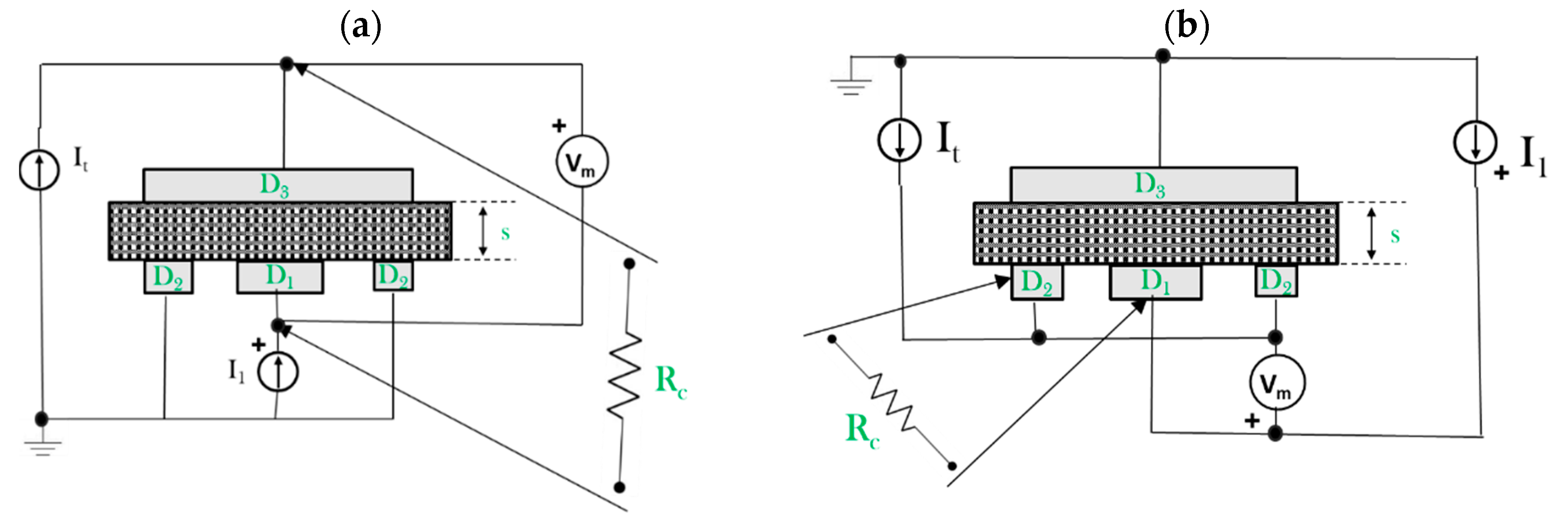
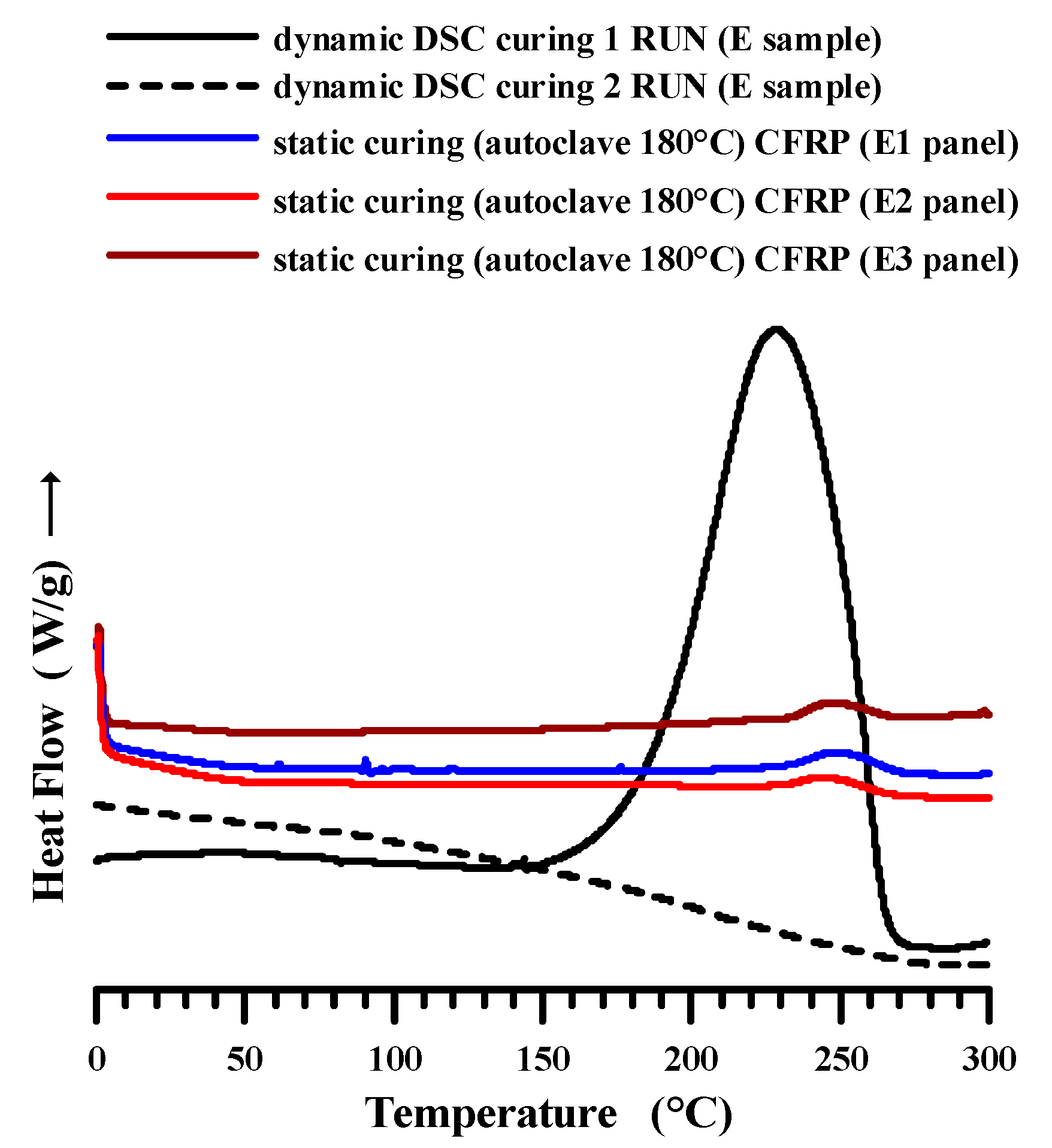





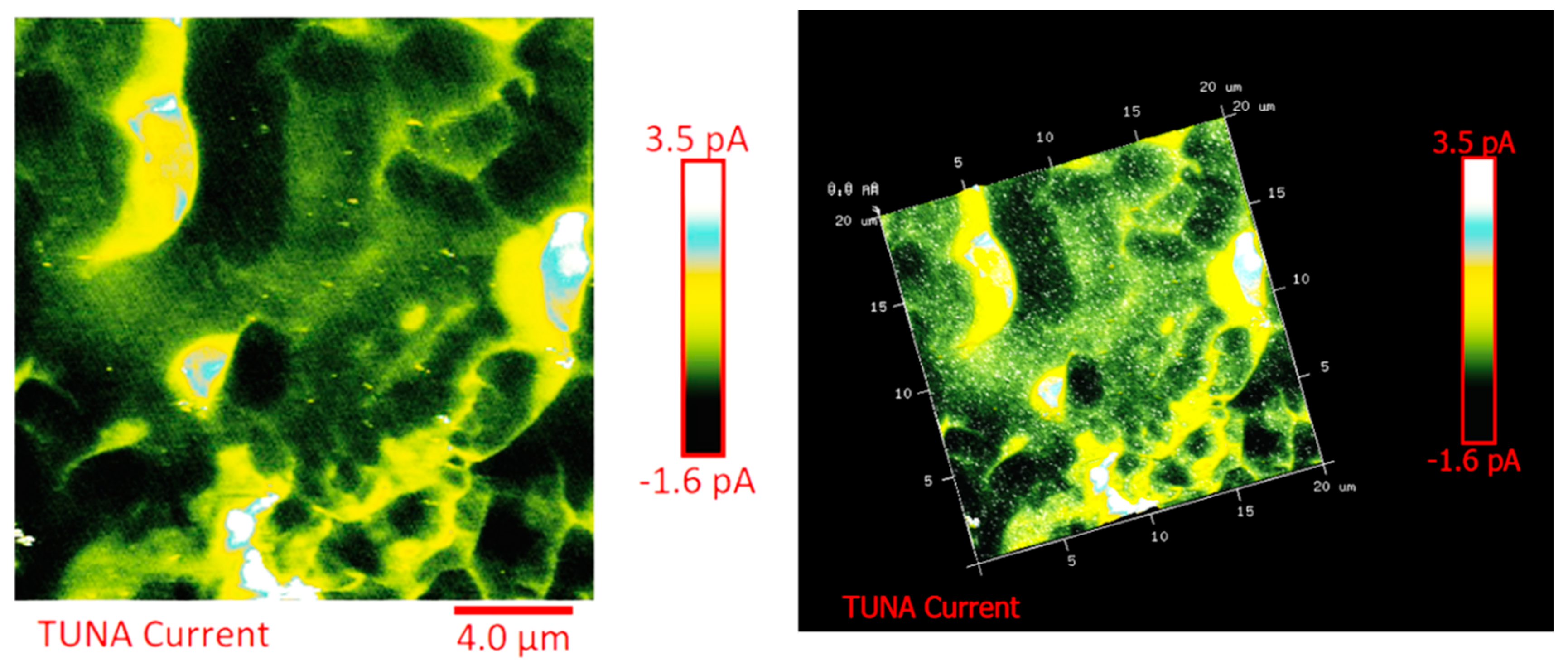
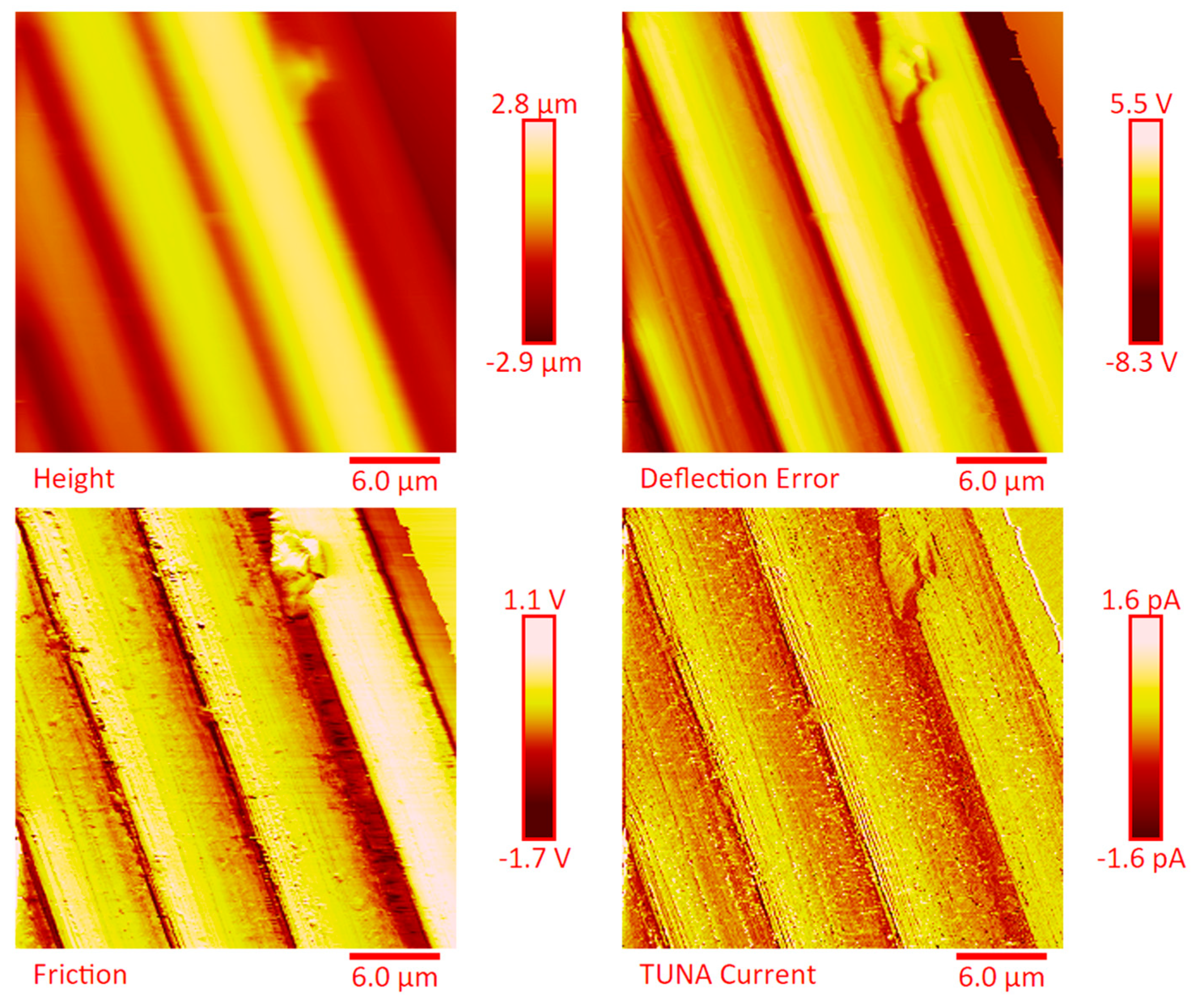
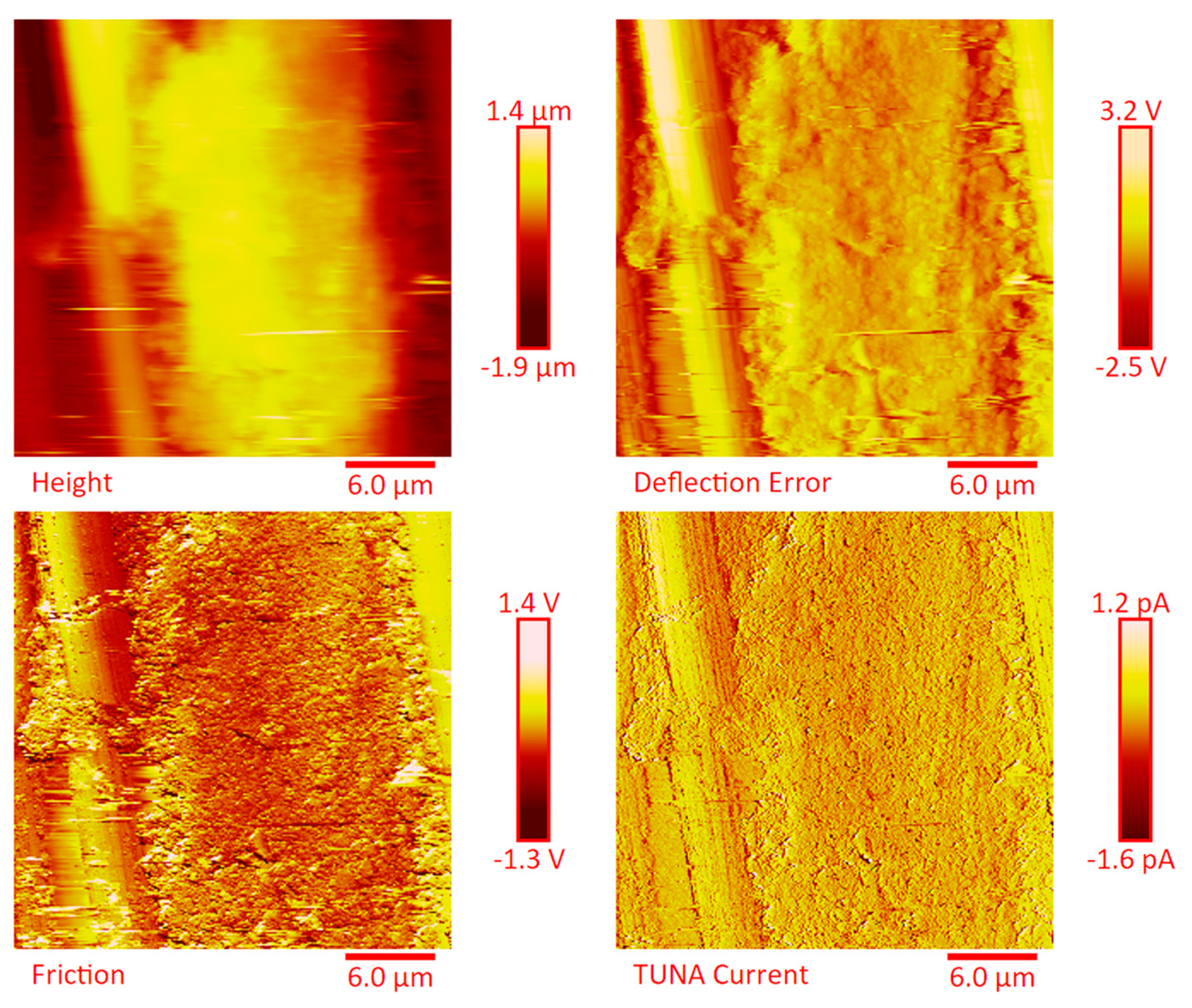
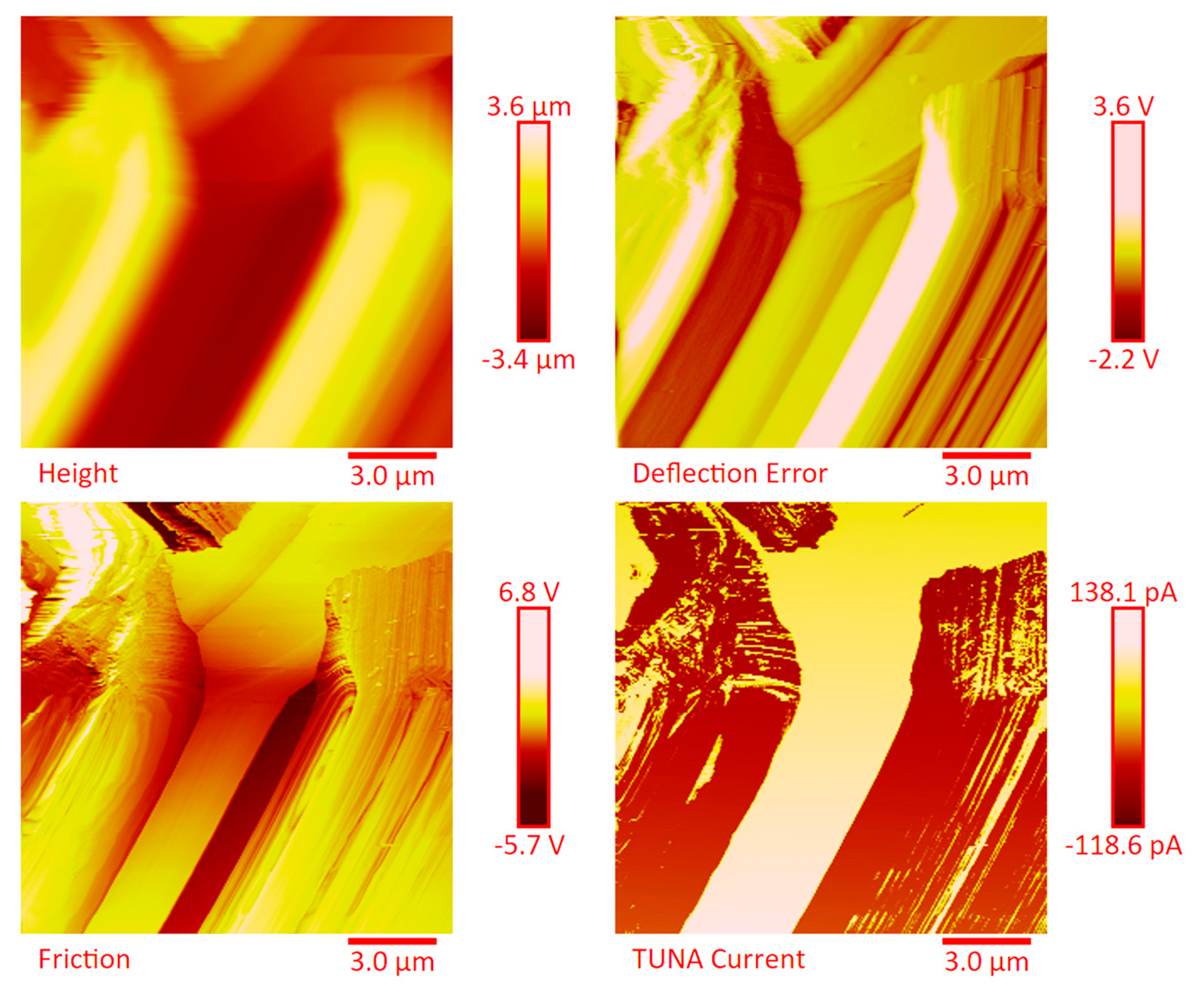

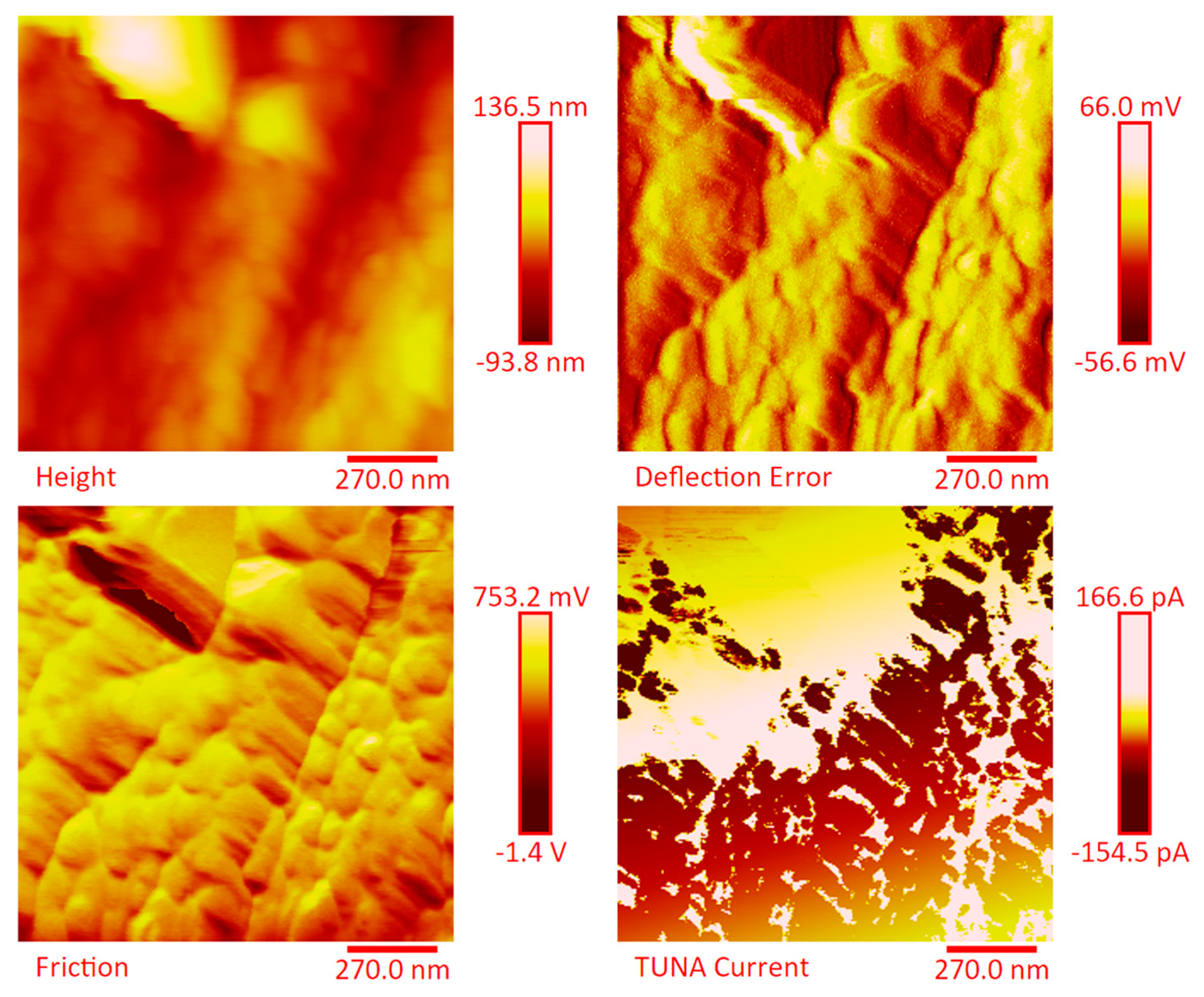
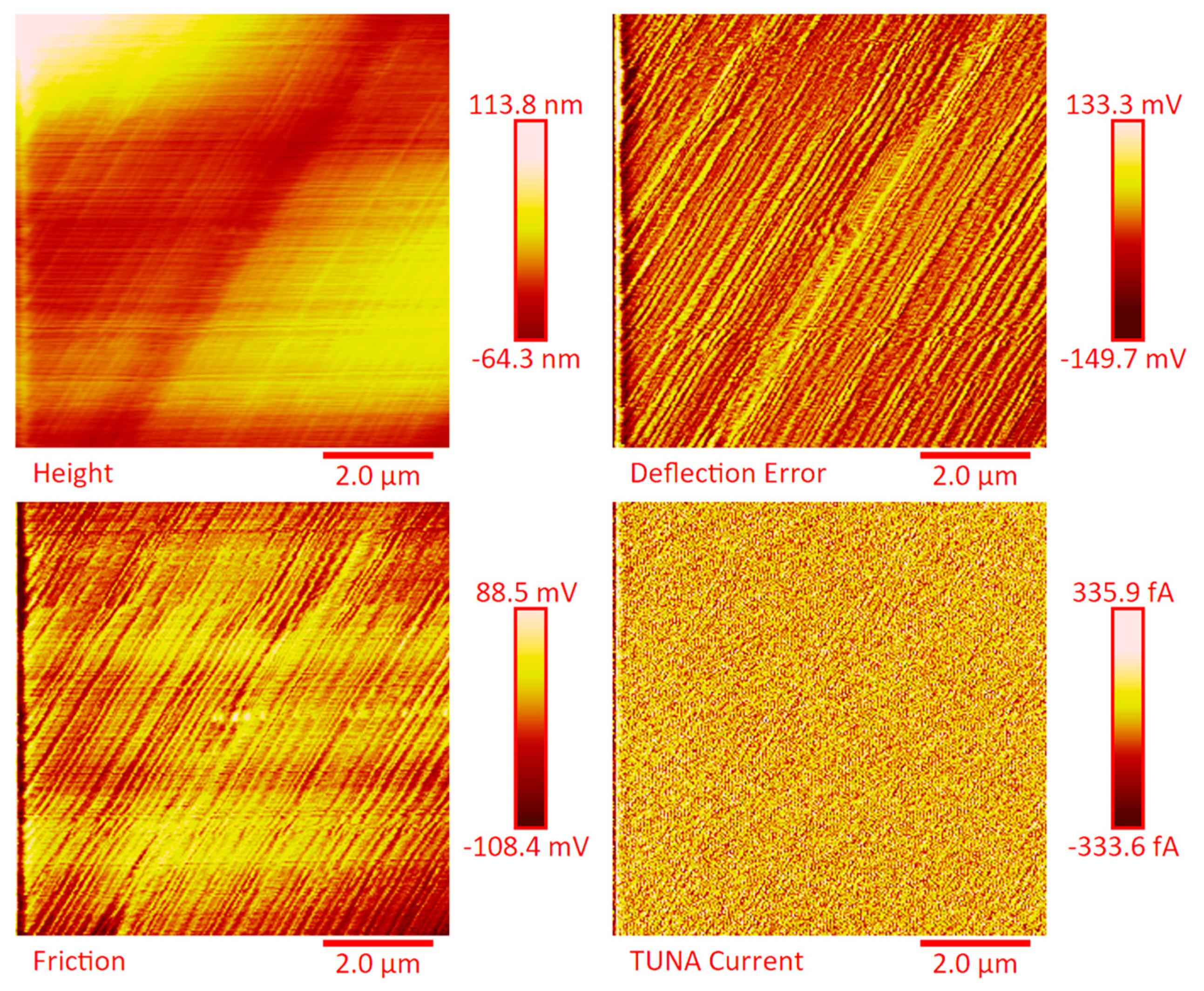
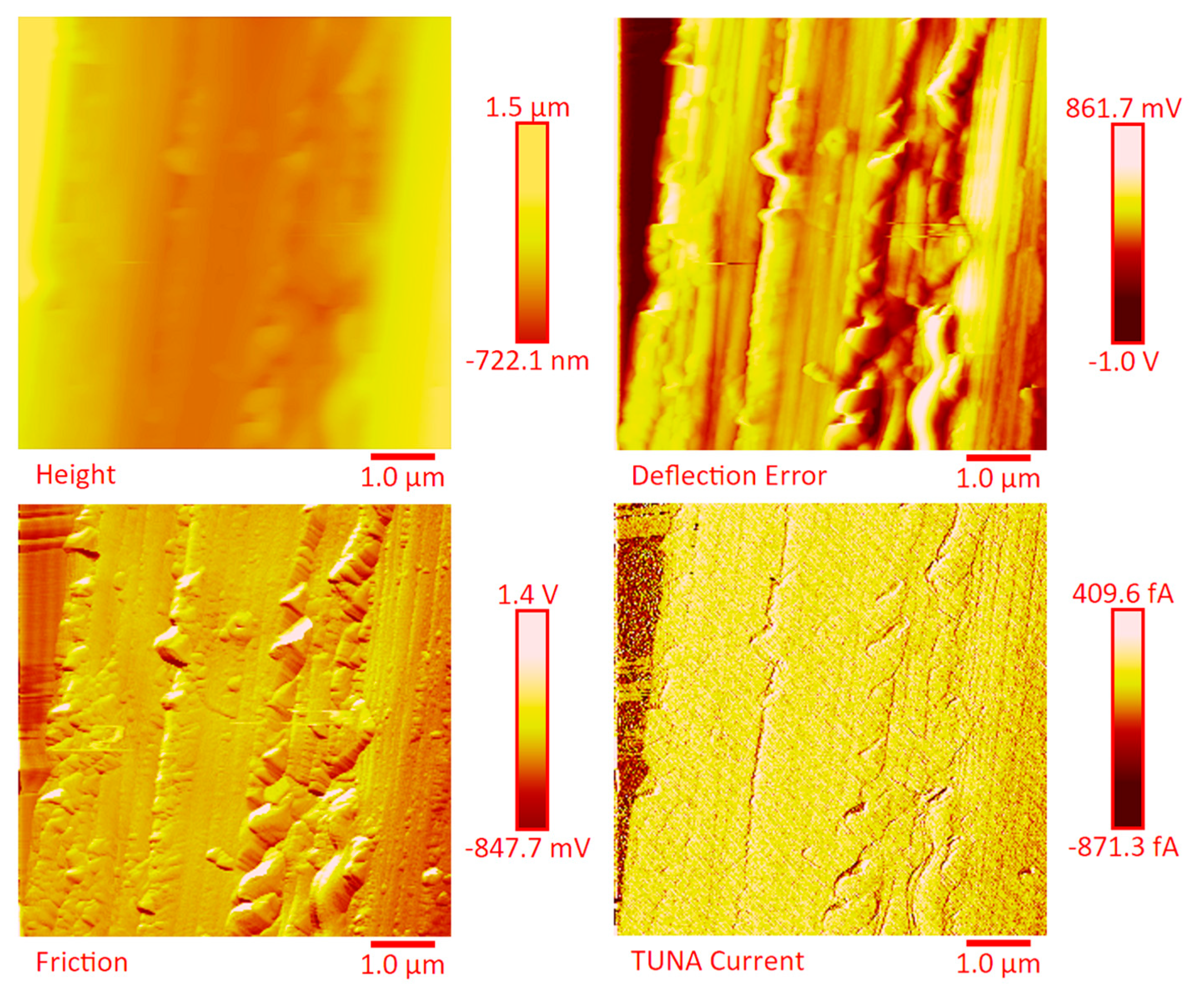

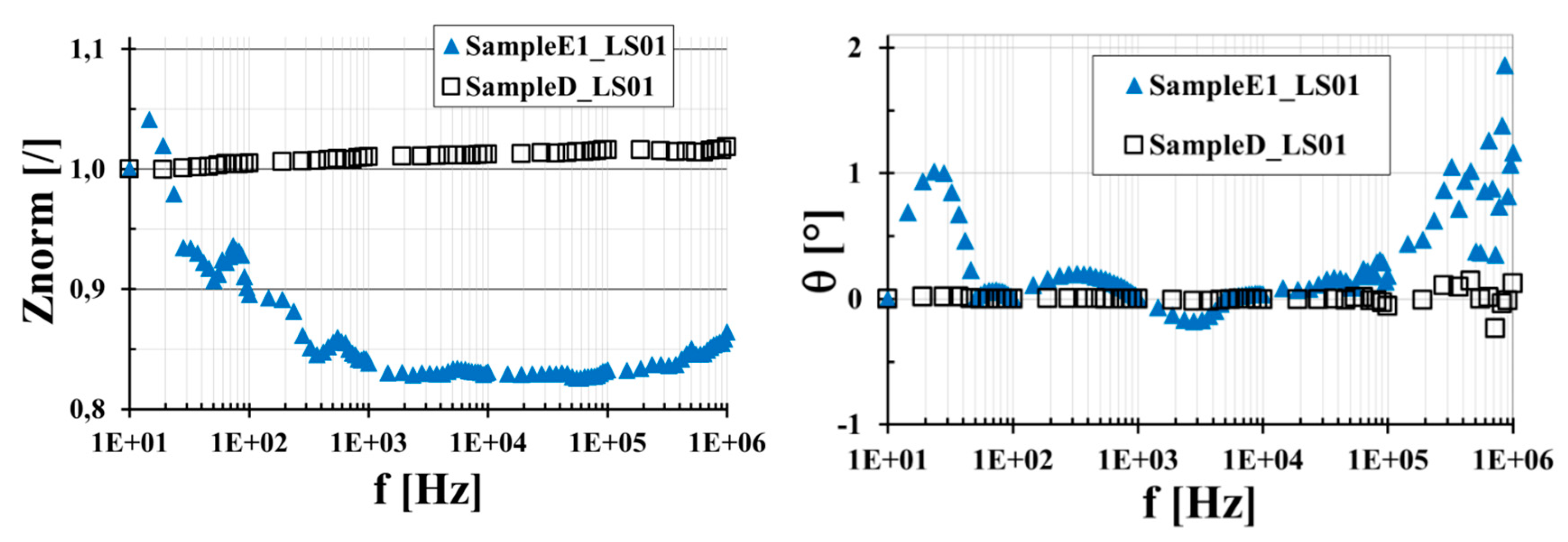
| Sample | CNTs (wt %) | GPOSS (wt %) |
|---|---|---|
| Pristine | - | - |
| Formulation D | 0.5 | - |
| Formulation E | 0.5 | 5.0 |
| Sample | No. of Plies | Resin Composition |
|---|---|---|
| Sample D | 7 | T25BD + 0.5% MWCNT |
| Sample E1 | 7 | T25BD + 5% GPOSS + 0.5% MWCNT |
| Sample E2 | 14 | T25BD + 5% GPOSS + 0.5% MWCNT |
| Sample E3 | 24 | T25BD + 5% GPOSS + 0.5% MWCNT |
| Sample | Curing Degree (%) |
|---|---|
| Formulation E (from the first run) | 100 |
| E1 panel | 94 |
| E2 panel | 96 |
| E3 panel | 96 |
| Samples E1 | Rc (mΩ) | σ//0° (S/m) | Δσ//0° (S/m) | Δσ//0° (%) | R2 |
|---|---|---|---|---|---|
| ST00_05 | 53.73 | 1.608 × 104 | 4.1 × 102 | 2.57 | 0.99 |
| ST00_06 | 49.82 | 1.545 × 104 | 4.0 × 102 | 2.61 | 0.99 |
| ST00_07s | 47.39 | 1.704 × 104 | 4.5 × 102 | 2.66 | 0.99 |
| Sample | E1 | E2 | E3 |
|---|---|---|---|
| No. of plies | 7 | 14 | 24 |
| σ//0° (kS/m) | 16.19 | 12.29 | 10.82 |
| Δσ//0° (%) | 2.6 | 2.3 | 2.2 |
| σ//45° (kS/m) | 12.10 | 12.06 | 14.26 |
| Δσ//45° (%) | 2.4 | 2.3 | 2.1 |
| σ﬩ (S/m) | 0.06 | 0.11 | 1.75 |
| Δσ﬩ (%) | 4.0 | 3.5 | 2.5 |
| σs (mS) | 55.50 | 3.35 | 3.31 |
| Δσs (%) | 4.7 | 4.7 | 5.5 |
| Sample | No. of Plies | σ//0 (S/m) | σ﬩ (S/m) | σs (S/m) |
|---|---|---|---|---|
| Sample D | 7 | 1.950 × 104 | 3.85 | 0.011 |
| Sample E1 | 7 | 1.703 × 104 | 0.11 | 0.055 |
© 2019 by the authors. Licensee MDPI, Basel, Switzerland. This article is an open access article distributed under the terms and conditions of the Creative Commons Attribution (CC BY) license (http://creativecommons.org/licenses/by/4.0/).
Share and Cite
Guadagno, L.; Vertuccio, L.; Naddeo, C.; Raimondo, M.; Barra, G.; De Nicola, F.; Volponi, R.; Lamberti, P.; Spinelli, G.; Tucci, V. Electrical Current Map and Bulk Conductivity of Carbon Fiber-Reinforced Nanocomposites. Polymers 2019, 11, 1865. https://doi.org/10.3390/polym11111865
Guadagno L, Vertuccio L, Naddeo C, Raimondo M, Barra G, De Nicola F, Volponi R, Lamberti P, Spinelli G, Tucci V. Electrical Current Map and Bulk Conductivity of Carbon Fiber-Reinforced Nanocomposites. Polymers. 2019; 11(11):1865. https://doi.org/10.3390/polym11111865
Chicago/Turabian StyleGuadagno, Liberata, Luigi Vertuccio, Carlo Naddeo, Marialuigia Raimondo, Giuseppina Barra, Felice De Nicola, Ruggero Volponi, Patrizia Lamberti, Giovanni Spinelli, and Vincenzo Tucci. 2019. "Electrical Current Map and Bulk Conductivity of Carbon Fiber-Reinforced Nanocomposites" Polymers 11, no. 11: 1865. https://doi.org/10.3390/polym11111865
APA StyleGuadagno, L., Vertuccio, L., Naddeo, C., Raimondo, M., Barra, G., De Nicola, F., Volponi, R., Lamberti, P., Spinelli, G., & Tucci, V. (2019). Electrical Current Map and Bulk Conductivity of Carbon Fiber-Reinforced Nanocomposites. Polymers, 11(11), 1865. https://doi.org/10.3390/polym11111865










